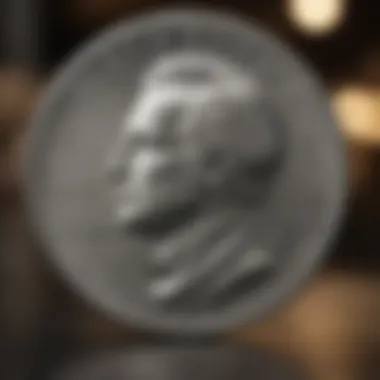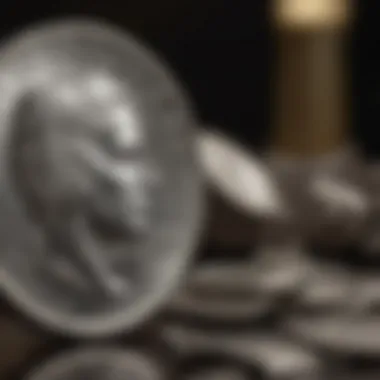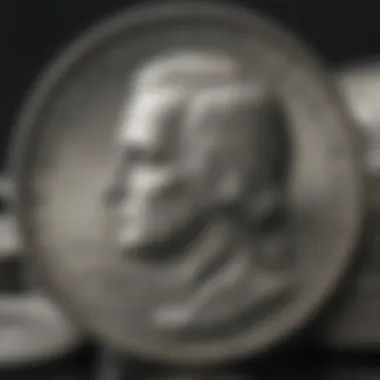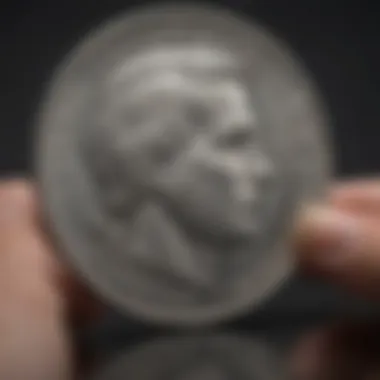Value Insights on the 1926 Silver Dollar Coin


Intro
When diving into the world of numismatics, few coins spark intrigue like the 1926 silver dollar. This particular coin is not just a pretty piece of metal; it encapsulates a chapter of history, art, and finance that collectors and investors alike find captivating. Its worth is influenced by various factors, from its minting details to current market trends. Understanding these elements is essential, whether you're a seasoned collector hunting for treasure or a newcomer to the coin-collecting realm.
Historical Significance of the Silver Dollar
The 1926 silver dollar, famously known as the Peace Dollar, was minted after World War I, a period marked by transitioning ideals of peace and recovery. With its striking design crafted by Anthony de Francisci, the coin features a depiction of Lady Liberty, reflecting hope for a more peaceful world. The historical context surrounding its minting adds layers of value to the coin, making it not just a collector's item, but also a symbol representing an era.
"Coins like the 1926 silver dollar tell stories not just about currency but about society's aspirations and tribulations."
Minting Details and Rarity Factors
The number of mintages influences a coin's value significantly. In 1926, the U.S. Mint produced several variations, with different mint marks resulting in varying levels of availability. The San Francisco mint released the most scarce version, thus elevating its desirability among collectors. Conversely, the Philadelphia mint, although producing the most coins, does not hold the same rarity appeal.
Mint Marks of 1926 Silver Dollar:
- No Mint Mark: Philadelphia Mint (common)
- S: San Francisco Mint (rare)
This variance in production not only affects the market but also guides prospective buyers toward informed investment decisions. Coin conditions also play a crucial role in its valuation. Coins graded as Mint State are obviously priced higher compared to those with signs of wear.
Market Value and Trends
The market for silver dollars, particularly the 1926 variety, fluctuates based on supply and demand dynamics. As of late, there's been a resurgence in interest, partly fueled by economic instability and the rise of precious metal investments. This shift has seen premiums on rare coins surge; savvy collectors understand the potential for profitable reselling.
Current Market Influences:
- Fluctuating silver prices
- Economic conditions affecting collector interest
- Increased online platforms for trading and selling
Understanding these aspects is vital. They not only inform collectors of potential returns but also of risks. While investing in coins can bring substantial profit, the collector must tread carefully, assessing market conditions and making timely decisions.
Investing in Silver Dollar
Whether you're looking to buy a single piece for a collection or consider it as a part of a diversified investment portfolio, knowing how to evaluate a coin is critical. Here's what to keep in mind:
Valuation Tips:
- Check current silver prices to understand the base value.
- Seek out reputable dealers and marketplaces for accurate price comparisons.
- Examine the coin's condition and grading to match your investment objectives.
In summation, the 1926 silver dollar holds a unique spot in both the hearts of collectors and the mechanics of financial investment. Imbuing both aesthetic qualities and historical significance, it stands as a testament to the intricate landscape of numismatics. Grasping its worth goes beyond basic valuations; it's about appreciating the journey these coins have taken and the story they continue to tell.
Prolusion to the Silver Dollar
The story of the 1926 silver dollar is more than just a tale of numismatics; it’s an exploration of history, art, and economy, all wrapped up in a shiny circular piece of metal. As we navigate through what makes this coin special, we'll highlight its significance in the broader context of American currency, showcasing not only its monetary value but also the rich history that it represents.
Understanding the importance of the 1926 silver dollar equips collectors and investors alike with the essential knowledge necessary to appreciate what they hold. It’s not merely about having a dollar that glints in the sun; it’s about grasping the narrative behind that dollar.
Within this article, we are set to delve into various elements such as historical context, minting facts, and market influences, which all play a crucial role in determining the coin's worth. Whether you're a seasoned collector or someone just getting their feet wet, knowing the foundational aspects of the 1926 silver dollar arms you with insights that can lead to informed decision-making.
Historical Context
The 1926 silver dollar was minted during a period often referred to as the Roaring Twenties. This decade was characterized by significant economic growth and social change in the United States. The aftermath of World War I had brought about a newfound prosperity and a shift in cultural norms. The economy was booming, with people embracing consumerism and new technologies.
This backdrop provides valuable context for the 1926 silver dollar. A number of significant events were unfolding, including the rise of jazz music, the flapper lifestyle, and increased industrialization. This period also saw a heightened interest in coin collecting as people sought physical representations of their times. For many, the 1926 silver dollar symbolizes both stability and uncertainty—an artifact that resonates with a moment in history that set the stage for the Great Depression soon to follow.
Minting Facts
When discussing the 1926 silver dollar, the minting process and mint marks are foundational to understanding its value. Produced in three primary locations—Philadelphia, Denver, and San Francisco—each mint represents a unique chapter in the coin's story.
- Philadelphia Mint: This mint produced the base flow of the 1926 silver dollars, retaining a significant quantity that appeals to both novice and experienced collectors. Coins stamped here lack a mint mark, serving as a hallmark of their origin.
- Denver Mint: The Denver mint added a “D” mint mark, indicating its unique place in the production line. Denver’s output included coins of notable quality and rarity—those who find one from this mint consider themselves fortunate.
- San Francisco Mint: Coins produced here bear the “S” mint mark. The San Francisco constancies have a much smaller mintage compared to their Philadelphia and Denver counterparts. As a result, collectors seek these out, often leading to a higher valuation.
All factors mentioned here mold the narrative around the 1926 silver dollar, from its inception to its current standing in the marketplace. By comprehending these details, investors and collectors can distinguish among the variations, enhancing both their collection and investment objectives.
Variations of the Silver Dollar
Understanding the variations of the 1926 Silver Dollar is crucial for anyone looking to collect or invest in these coins. Different mint marks and design differences play a significant role in determining the value and desirability of a particular coin. Not only do these variations reflect the minting practices of the time, but they also offer insights into the history of coinage in the United States.
Some collectors enjoy the thrill of hunting down different mint marks, as each one has its own unique characteristics and value. Knowing what distinguishes each type can make all the difference when it comes to maximizing your investment or enhancing your collection.
Different Mint Marks
The mint marks found on the 1926 Silver Dollar—Philadelphia, Denver, and San Francisco—are vital identifiers that hold historical and monetary significance. Each mint has its quirks that set them apart.


Philadelphia Mint
The Philadelphia Mint was the primary location for striking coins in the U.S. at the time the 1926 Silver Dollar was produced. One key aspect to note is that coins minted here lack a mint mark, which is significant in itself. The absence of a mark may seem like a simple detail, but it hints at the coin's origin and adds to its mystique.
Coins from the Philadelphia Mint are commonly viewed as a popular choice for collectors due to their historical importance and abundance. However, the challenge lies in the sheer volume produced. More offerings generally mean lower prices unless further rarity factors kick in.
Also, coins from this mint tend to exhibit finer details in their engraving compared to others, making them visually appealing to those who appreciate such craftsmanship. This can be a distinct advantage when considering aesthetics, enhancing both personal collections and potential resale value.
Denver Mint
The Denver Mint is known for producing coins that carry a unique appeal, with a small "D" mint mark identifiable on the reverse side. One important aspect of the Denver Mint's output is that its coins were generally struck in lower quantities than those from Philadelphia. This results in a higher rarity factor, which can make these coins particularly attractive to serious collectors.
Another key characteristic of the Denver Mint's 1926 Silver Dollars is their quality. Typically, coins from Denver present well in terms of condition. They often feature clean surfaces and sharp definitions of detail. Such qualities can push the coin’s price higher in the marketplace, appealing to both numismatists and investors alike.
However, it’s essential to note that the demand may fluctuate, chiefly influenced by the ongoing collector interest and market trends. Thus, although generally prized, this coin type may experience variability in value.
San Francisco Mint
San Francisco, on the other hand, is known for producing coins with a distinctively high level of artistry, often regarded by collectors as some of the finest examples. The tiny “S” mark on these coins signifies their origin and serves as a point of interest for collectors eager to find more unique pieces.
The San Francisco Mint also produced fewer coins than its counterparts, enhancing their rarity and resulting in potentially higher market values. This scarcity is a double-edged sword; while it can attract enthusiasts seeking exceptional pieces, it can also mean fewer coins available to purchase, driving prices up.
A unique feature worth mentioning is that coins from the San Francisco Mint may occasionally have minor variations in design compared to their counterparts, adding a layer of intrigue for collectors focused on the specifics of coinage.
Overall, understanding the differences in mint marks can guide purchasing decisions. Whether convenience is an issue or you're on the hunt for rare coins, recognizing the essential traits of each mint would get collectors and investors closer to their objectives.
Design Differences
The differences in design, while not as pronounced as the variations created by the mint marks, still play a role in informing collectors about a coin's history and can affect value. Design elements can vary subtly, impacting their demand in the market. Looking at these design details can thus expand your appreciation for the craftsmanship behind the 1926 Silver Dollar.
Factors Influencing Value
Understanding the factors that influence the value of the 1926 silver dollar is crucial for any collector or investor looking to navigate this market. Value isn’t set in stone; it ebbs and flows based on various elements, such as condition, rarity, demand, and market trends. Each of these components plays a significant role, not just in establishing a base value, but also in determining how that value might change over time. Knowing what drives these prices can help enthusiasts make informed decisions and avoid potential pitfalls in the collecting journey.
Condition Assessment
Grading Systems
Grading systems serve as a crucial tool in evaluating the condition of a silver dollar. They provide a structured way to classify coins based on their wear and overall appearance. This classification is made through a set of standards that assess factors like luster, scratches, and overall visual appeal. The Sheldon Scale, ranging from 1 to 70, is one of the most recognized grading systems. The higher the grade, the more desirable— and valuable— the coin becomes.
The benefit of having such a structured grading system is that it offers a common language among collectors and dealers. This uniformity helps in price negotiations and reduces ambiguity about a coin’s worth.
A unique feature of grading systems is their reliance on visual inspection and expert judgment, which can sometimes lead to subjective interpretations. Prospective buyers should familiarize themselves with these criteria to better assess value, but it's worth noting that over-reliance on grades alone could lead to missed opportunities— sometimes a coin's charm isn’t captured by a strict numeric value.
Visual Inspection Techniques
Visual inspection techniques are another vital aspect of condition assessment. These methods allow collectors to closely analyze the physical attributes of the coin before any grading is conducted. Techniques might include using magnifying glasses or professional lighting to spot minute flaws or details hidden from the naked eye.
A key characteristic is the ability to identify signs of wear or alterations that could impact the coin’s market value drastically. Understanding how to conduct a solid visual inspection is beneficial as it can save money by preventing overpaying on a lesser-condition coin.
One downside of solely relying on visual inspection, however, is that it can't always substitute expert grading. In some cases, subtle variations might go unnoticed unless an expert examines them. Nonetheless, having a keen eye and knowing what to look for is essential for anyone serious about collecting.
Rarity and Demand
Market Availability
Market availability refers to how frequently a specific coin is found in circulation or among dealers. This aspect is critical to understanding its rarity. The less commonly a 1926 silver dollar appears on the market, the greater demand it tends to generate among collectors. A key component of market availability is specific minting details; coins from the San Francisco Mint, for example, are often rarer than those from the Philadelphia Mint.
This scarcity often drives up the price. When coins are harder to come by, collectors are willing to pay more to add them to their collections.
However, a unique feature of this dynamic is that it can shift based on market trends—a spike in interest can quickly alter availability as enthusiasts hunt for particular types of coins. On the flip side, when supply exceeds demand, values can plummet, showcasing the importance of understanding market conditions thoroughly.
Collector Interest
Collector interest is a powerful driving force behind the value of a coin. It's not just when the market is flooded with coins; it’s the passionate pursuits of both seasoned and new collectors seeking to expand their collections that fuel demand.
The key characteristic of collector interest is its fluctuating nature—trends can vary drastically based on new discoveries, popular media, or even social influences. For instance, if a prominent figure were to talk about their love for collecting silver dollars, interest may spike. An increase in collector interest typically puts upward pressure on prices.
An advantage of being aware of collector interest is that it can serve as a guiding light in investment decisions. Recognizing which coins are currently trending can lead to more substantial investments, but also advisory caution is needed; trends can be fleeting.
Market Trends
Historical Price Fluctuations


Past price fluctuations provide a wealth of information about the coin's market trajectory. For the 1926 silver dollar, prices have seen numerous ups and downs over the decades. Historical trends can reveal factors influencing such movements—be they economic conditions, changes in collector interest, or fluctuations in silver prices. Understanding these patterns helps establish a baseline for future valuations.
Rather than merely historical data, the unique feature of examining these fluctuations lies in the opportunity to forecast potential future outcomes. Recognizing when a certain price point is unusually low can give savvy collectors the chance to acquire coins that are likely to appreciate in value over time.
However, caution is needed: just because a coin once commanded a high price doesn’t guarantee it will do so again. Constant market evaluation is critical.
Current Market Insights
Current market insights help gauge the present state of the silver dollar market, observing how ongoing events, like economic instability or fluctuations in silver coin prices, affect value. Regularly following resources like numismatic forums or financial news outlets can yield significant insights.
A beneficial aspect is being able to access real-time data that can inform quick decision-making. It allows collectors to adjust their strategies based on immediate findings and emerging trends, a critical skill for anyone serious about investing.
The unique feature of this market analysis is that it relies on immediate feedback loops from active collectors and dealers, laying the groundwork for a more engaged investment approach. However, it's important not to get swept away by momentary excitement; a thorough analysis grounded in which trends have staying power is invaluable.
Evaluation and Appraisal
In the world of numismatics, the journey towards understanding the value of any coin, such as the 1926 silver dollar, begins with a firm grasp of evaluation and appraisal techniques. This section serves as a touchstone for both novice collectors and seasoned investors. An in-depth appraisal not only provides an estimated monetary value but also aids in understanding the broader context within which this coin resides. Grasping the nuances of evaluation can reshape a collector's approach to buying, selling, and assessing coins.
One key element of evaluation is the recognition that the worth of a coin isn’t just dictated by its face value or silver content; rather, the demand, condition and historical significance come into play heavily. Navigating this landscape can be challenging, yet essential for any serious collector or investor.
Professional Appraisal Services
When diving into the world of coin appraisal, turning to professional services can be a comforting option. Professional appraisers bring a wealth of knowledge and experience to the table, typically providing detailed reports that outline the grading, market value, and condition of coins, including the 1926 silver dollar. The benefit of these services is multifaceted:
- Expert Analysis: These professionals have trained eyes to spot minute details that might escape a layperson's notice.
- Market Insights: They often have access to the latest market trends and can provide insight based on current economic conditions.
- Trustworthy Valuation: Having your coin appraised by an established appraiser can lend credibility to the valuation, especially if you’re considering selling.
However, it’s critical to select a reputable appraiser. Always check credentials and possibly seek recommendations from fellow collectors to ensure you receive a fair and thorough evaluation.
Do-It-Yourself Approaches
While relying on professionals has its perks, many collectors prefer to assess their coins on their own. With a plethora of tools and resources available online, a DIY approach can be both educational and empowering.
Online Resources
Online resources allow collectors to research the 1926 silver dollar and its worth from the comfort of their homes. One key characteristic of these platforms is the sheer abundance of information. From price guides to grading standards, these resources can drastically facilitate one’s learning experience.
For example, websites like Wikipedia and various collector forums present comprehensive insights that can help steer evaluations in the right direction. A unique feature of online resources is the user-generated content; it provides real-world insights, testimonials, and recent sales data that can shape a collector's expectations.
Advantages:
- Accessibility: Information is available 24/7.
- Variety of Perspectives: Obtain multiple viewpoints on grading and valuation.
Disadvantages:
- Overwhelming Information: Sifting through vast amounts of data can be daunting.
- Quality Control: Not all online resources are credible, requiring careful vetting by the user.
Community Forums
Community forums offer a rich tapestry of experiences shared by fellow collectors. These platforms foster interaction and exchange of information on various aspects of coin collection, including evaluation techniques. A standout characteristic of community forums is engagement; collectors can ask questions, seek clarifications, and even share their appraisal experiences.
Being part of a community can provide invaluable support and insight. The unique feature of such forums is the immediate feedback one can receive, often from individuals who have similar collectibles.
Advantages:
- Real-time Support: Quick answers from knowledgeable peers.
- Networking Opportunity: Build connections with other collectors.
Disadvantages:
- Varied Expertise: Not all members may possess the same level of knowledge.
- Potential Misinformation: Like online resources, forums may feature incorrect information that needs verification.
"Understanding the nuances of coin evaluation can lead to not only financial gain but also personal satisfaction in building a comprehensive collection."
Investment Considerations
When discussing the 1926 Silver Dollar, it’s crucial to delve into the topic of investment considerations. Collecting coins is not merely a hobby for many; it represents a strategic financial move. Factors such as potential appreciation and market trends can influence decisions to acquire this unique piece of numismatic history.
One of the core components of investment is understanding the long-term vs. short-term investment strategy. This distinction will guide collectors and investors alike in making informed choices about their collections.
In addition, employing diversification strategies is a prudent approach to mitigate risks associated with coin collecting. Relying solely on the value of the 1926 Silver Dollar might not always yield the desired returns, especially given the fluctuating nature of collectibles.
Lastly, addressing the risks associated with collecting is imperative. Elements like market volatility and the presence of fakes or counterfeits can significantly affect one’s investment. Investors need to have a keen eye and a solid understanding to navigate these challenges successfully.
Long-Term vs Short-Term Investment


Investing in the 1926 Silver Dollar can take on two distinct forms.
- Long-term investments often mean holding onto the coin for years, benefitting from its value appreciation over time, as historical context and rarity enhance desirability. Think of it like a fine wine developing more richness with age.
- Short-term investments require a more active approach, buying low and hoping to sell at a higher price quickly. This approach can be akin to flipping houses—risky but potentially rewarding.
Each strategy comes with its own pros and cons, and choosing the right one largely depends on individual circumstances and objectives.
Diversification Strategies
When looking to spread investments across different areas, diversification strategies can help shield investors from the risks tied to the 1926 Silver Dollar's value. Consider these options:
- Invest in various coins: Collecting different types, like gold or other silver coins, can spread out risk.
- Include other collectibles: Art, stamps, or antiques can create a well-rounded portfolio, reducing dependence on a single asset.
- Combine physical and digital assets: As blockchain technology becomes prevalent, incorporating digital currency alongside tangible investments may provide a modern edge.
Diversification does not simply minimize risk; it also opens doors to new opportunities and may enhance overall returns.
Risks Associated with Collecting
Collecting the 1926 Silver Dollar is not devoid of risks. Two significant concerns arise:
Market Volatility
Market volatility refers to the unpredictable fluctuations in prices and demand. For instance, occasionally, there may be a spike in interest due to media coverage or emerging trends.
- Key characteristic: Market volatility manifests through the highs and lows in prices, often driven by collector enthusiasm or external economic factors.
- Benefits: While it can enable savvy investors to reap quick profits, it can also be a double-edged sword when prices plummet unexpectedly.
The inherent nature of volatility makes it essential for any collector to stay attuned to market trends and adjust their strategies accordingly.
Fakes and Counterfeits
The presence of fakes and counterfeits poses a constant challenge in the realm of coin collecting.
- Key characteristic: Counterfeit coins can mimic the appearance of originals closely, often deceiving even the seasoned collector.
- Importance for collectors: Awareness of these fraudulent pieces is vital because investing in a counterfeit can lead to significant financial losses and disappointment.
Investors should familiarize themselves with credible inspection methods and utilize professional appraisal services where necessary to ensure the authenticity of their coins.
"Knowledge is power in the world of coin collecting. Without it, one might unknowingly invest in pratices that lead only to regret."
Whether through long-term strategies, diversifying assets, or navigating the risks involved, a careful and informed approach will greatly enhance any investment in the 1926 Silver Dollar.
The Future of the Silver Dollar
When looking at the landscape of coin collecting and investing, the future of the 1926 silver dollar is a significant topic. This particular coin, with its intriguing history and potential for value appreciation, holds a unique spot in the hearts of collectors and investors alike. Understanding where this coin may be headed is not just for the hardcore numismatic enthusiast but also for those dipping their toes into the world of silver dollar investing.
Forecasting Trends
To gauge the future, one must always look to the past and present market behaviors. With the increasing popularity of collectible assets, silver dollars like the 1926 version have become focal points for investment strategies. As collectors continue to share stories and insights on platforms like Reddit, the community's enthusiasm often fuels market demand.
- Market Dynamics
- Collector Demand: As younger generations get involved in coin collecting, interest in historical coins is likely to grow.
- Economic Factors: The price of silver reacts to broader economic changes. As inflation rises, so does the appeal of tangible assets like silver coins.
- Investment Shifts: More individuals are diversifying their portfolios with tangible assets which include coins.
"The silver dollar is not merely a piece of metal, it's a story, a slice of history, and a potential investment all rolled into one."
By keeping an eye on these trends, investors can better prepare for potential fluctuations in the market. Historical performance can provide clues, but new collectors bringing fresh energy into the field may shift the dynamics significantly.
Potential for Appreciation
The potential for appreciation in the value of the 1926 silver dollar is largely influenced by several core factors that observe both the micro and macroeconomic environments.
- Scarcity plays a vital role. Coins from certain mints, like the San Francisco Mint, are rarer and may command a higher price in the future due to limited supply.
- Condition of Coins: The state of individual coins, graded through established systems, can affect desirability and worth. Even minor variations can lead to large differences in price appreciation.
- Market Trends: As observed in the past, when silver prices rise globally, the demand for vintage coins often spikes. Collectors and investors could witness an upward trajectory in the value of their collections, including the 1926 silver dollar.
Investing isn't without its risks. Market volatility, potential counterfeit coins, and broader economic considerations must all be kept in mind.
By assessing these elements thoughtfully, one can make informed predictions about the likely future of the 1926 silver dollar. Exploring its unique qualities, alongside understanding market behaviors, aids in painting a picture of where the journey of this beloved coin may lead.
Epilogue
In summing up the intricate details laid out in this article, one must appreciate the 1926 silver dollar not just as a mere coin, but as a treasure steeped in history and value. Understanding its worth encompasses various aspects—from the historical context surrounding its minting to the multiple variations that exist. This detailed exploration is crucial for anyone delving into the realm of collecting or investing in silver dollars.
Summary of Key Points
- Historical Significance: The 1926 silver dollar embodies a snapshot of American history, reflecting the era's economic landscape and societal values.
- Minting Variations: Differences in mint marks and design elements significantly impact the coin's value, making knowledge of these variances essential for collectors.
- Condition and Rarity: The condition of the coin, as assessed through established grading systems, coupled with its rarity, plays a pivotal role in determining market value.
- Market Trends: Keeping an eye on historical price fluctuations and current trends offers insight into potential investment outcomes. This active monitoring is key for smart investments.
- Future Potential: A discerning perspective on potential future appreciation can guide collectors and investors in making informed decisions about their silver dollar portfolios.
Final Thoughts on Collecting and Investing in Silver Dollars
Collecting and investing in the 1926 silver dollar offers a fascinating combination of historical intrigue and financial potential.
- Diversification of Investments: A collector might effectively enhance their investment portfolio by including silver dollars due to their tangible nature and intrinsic value. Silver has always held a spot in traditional investment strategies, functioning as a hedge against inflation.
- Understanding Risks: However, venturing into this arena is not devoid of risks. Market fluctuations and potential counterfeit coins in the market present challenges that savvy investors must navigate carefully.
- Passion Meets Profit: Beyond financial considerations, the journey of collecting coins can ignite a genuine passion for history and artistry. Each coin has its own story, making the venture more than just an investment; it's also about appreciation and education.
Ultimately, deepening one’s knowledge about the 1926 silver dollar empowers collectors and investors—not just arming them with facts, but also enriching their experience in the numismatic world. As you set off to explore this enticing field, keep these insights in mind; they will serve as your compass in the fascinating, sometimes unpredictable landscape of coin collecting.







